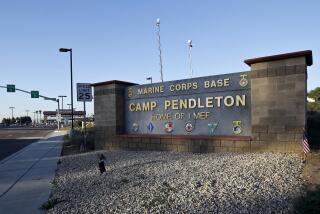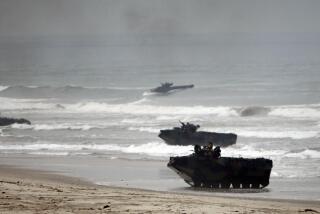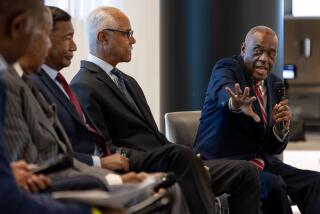End of Old Corps : Last Active-Duty Marine to See WWII Action Retires
- Share via
When Chief Warrant Officer Charles B. Russell leaves Camp Pendleton Friday, a proud piece of Marine Corps history will go with him.
At age 62, Russell is the last Marine still serving who saw active duty during World War II, according to Department of Defense records. His retirement Friday marks the end of a wartime era that saw 669,000 Marines on active duty.
“I spent a lot of years getting up at 4:30 in the morning and putting on that green uniform with the globe and anchor,” a talkative and upbeat Russell said during a press conference Monday.
“It’s going to be a shock not to do that anymore, but I believe I’m programmed to sit back and relax now,” he said.
Russell was a high school student in Ottumwa, Iowa, when his draft notice came in the fall of 1943. He went to Des Moines for a mass physical along with 200 other draftees.
“I got all done with the physical and an Army sergeant was reviewing my papers,” Russell recalled. “I’m standing there in front of him, semi-naked, 18 years old, when he asks whether I want Navy or Army. I said it didn’t make any difference.
“A man behind him, with red stripes down his pants, said, ‘Put down M.C.’ I thought that meant medical corps.”
What it meant was a one-way ticket to the San Diego Marine Corps Recruit Depot in January, 1944. From there, he was trained at old Camp Del Mar, now part of Camp Pendleton, as an amphibious tractor crewman.
Russell saw combat at two of the bloodiest and most decisive battles of the war against Japan: the struggle for the South Pacific island of Peleliu in September, 1944, and the assault on Okinawa in April, 1945.
“Peleliu was hell,” Russell said. “It was not only hot--seven degrees (latitude) off the Equator--but it was a well-planned defensive island. They were throwing everything at us when we landed. We weren’t sure until the third day of fighting that we could even hold the beach.”
The landing at Okinawa was deceptively easy.
One Bloody Mess
“We were pretty near unopposed because the 5th Army had fooled the Japanese on where the landing would take place,” Russell said. “It ended up being one bloody mess all the way, though, as we went around the south end of the island.”
After World War II, he left the Marines to run a service station for eight years. He returned in 1954 and was promoted to warrant officer in 1966.
He went to Vietnam in 1969 and was injured during a rocket attack. Vietnam remains a bitter memory.
“I read extensively about World War II--books about actual experiences and histories--and I watch the videos they have out now, but I have little on the Korean War and nothing about the Vietnam conflict,” Russell said.
“I didn’t like it. I didn’t enjoy it. I make no reference to it. We were not allowed to fight a war that we were trained to fight.
“We suffered many, many casualties that I think were not justified because we were not allowed to declare an all-out offensive.”
When he retires to his home in Fallbrook, Russell will have served 36 years, the last eight as an ordnance officer at Camp Pendleton, running the armory for the School of Infantry. He and his wife, Carol, want to do some traveling before letting retirement settle in.
Not Sentimental
Russell is a decidedly unsentimental sort.
No complaining about the disappearance of the Old Corps. No dispute with the move toward more highly educated enlisted personnel and more women in non-combat jobs. No grousing about the added concern for dependents and on-base housing.
“Marines are far better off today than compared to World War II,” Russell said. “We have better equipment, better uniforms, better training. True, the young men and women of today when you give them an order, they want to know why.
“There is no more of this dumb order: Go charge. But as long as you give them a legitimate reason, they’ll charge all day long.”
He does allow himself one bit of nostalgia.
“As far as I’m concerned,” he said, “there is only one rifle ever produced: the old M-1. I have great respect for the M-16A2 we use now, but the M-1, that was a rifle.”


